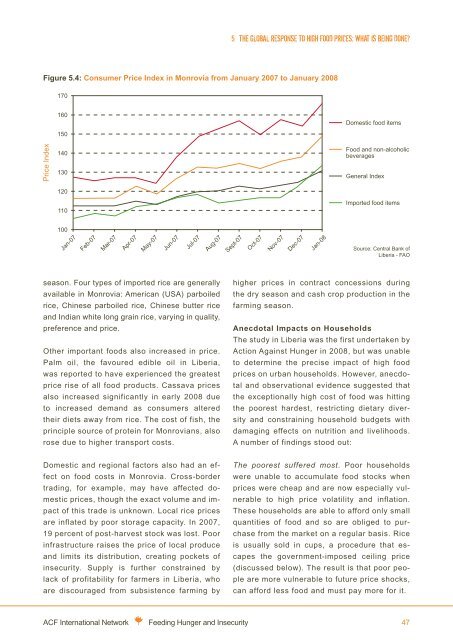5. The global response to high food prices: what is being done?5.2.4 The Scramble for AgriculturalL<strong>and</strong>The high food prices have spurred a number of middle<strong>and</strong> upper-income countries to lease or buy agriculturall<strong>and</strong> in poorer nations with the intention ofshipping produce back to their own domestic marketsin an effort to protect national food security (Borger2008). In 2007, China acquired access to 1.24 millionhectares of Filipino l<strong>and</strong>, in 2008, the Governmentof South Korea announced plans to purchase690 thous<strong>and</strong> hectares of arable l<strong>and</strong> in Sudan <strong>and</strong>has recently supported Daewoo Logistics negotiatea 99-year lease for 1.3 million hectares of l<strong>and</strong> inwestern Madagascar (Borger 2008). China, SouthKorea <strong>and</strong> Saudi Arabia are the largest investors todate, but other countries, including the United ArabEmirates, Japan, Egypt, Libya, Qatar, Kuwait <strong>and</strong>India, are making similar advances, particularly inAfrica <strong>and</strong> South East Asia (Borger 2008).Generally, poorer nations have been pushed bybilaterals <strong>and</strong> multilaterals to attract foreign investments,but in the present political climate, there isan air of uncertainty surrounding the deals. Thereis certainly a danger of marginalised groups <strong>and</strong>poor farmers with poor access to l<strong>and</strong> losing outfurther – with the potential of sparking protest. InLaos, wealthy elites have been selling large tractsof l<strong>and</strong> to foreign investors at prices below the marketrate, for forestry or agricultural purposes. Smallholderfarmers, who were forced to vacate their l<strong>and</strong>for minimal compensation have begun to rebel insome regions by burning the plantation crops <strong>and</strong>machinery (MacKinnon 2008). Foreign investmentis regarded as necessary for economic development,but can have anti-developmental effects bycreating dependency <strong>and</strong> building inequality. Moreefforts must be made to support civil society groupsmonitor <strong>and</strong> influence the way national investmentsare negotiated.5.3 Case Study 3: Responses to theFood Crisis in Monrovia, LiberiaResearch conducted on behalf of Action AgainstHunger in Liberia provides a more localised pictureof responses to the Global Food Price Crisis. TheLiberian economy has been severely affected bythe two civil wars fought between 1989 <strong>and</strong> 2003.Petroleum <strong>and</strong> food are Liberia’s greatest importsat 25 <strong>and</strong> 24 percent of total imports (rice accountsfor 65 percent of food imports). This reliance onimported food <strong>and</strong> fuel has seen the Liberian tradedeficit widen gradually since 2005 as global pricesincreased – oil by 37 percent <strong>and</strong> food by 280 percentin this period.Despite great potential (some areas may permitthree harvests per year), food production has neverreally been developed, rendering local produceuncompetitive. Transportation networks are poor,restricting the commercialisation of local production<strong>and</strong> forcing urban coastal populations to becomemore reliant on imports for food. Ninety-twopercent of rice consumed in urban Liberia is imported,making the population highly vulnerableto changes in global food prices as seen over thepast two years.Food <strong>and</strong> Oil Prices Increase DramaticallyThe cost of basic food stuffs in Monrovia has beenincreasing since 2006 – with a more pronouncedrise in prices starting in late 2007 – affecting rice,cassava, palm oil, vegetable oil, fish <strong>and</strong> meat.The Central Bank of Liberia estimated the 2007inflation rate of food at about 19 percent, 10 percentfor imported goods <strong>and</strong> 26 percent for localproduce (see figure 5.4 overleaf).Food price inflation in 2008 was higher than in2007. Imported rice is the primary staple food formost Monrovians, followed by cassava, but supplywas limited in early 2008, <strong>and</strong> prices increased by33 percent in the first few months of the year. Thereliance on rice imports has left the Monrovianmarket sensitive to external fluctuations in price<strong>and</strong> supply. Trade restrictions on rice imposed byIndia <strong>and</strong> China significantly constrained rice importsin Liberia as the cost of importing a ton ofrice rose from US$ 400 in October 2007 to over$1,000 per ton in mid-2008 contributing to the highdomestic prices experienced in the annual lean46ACF International Network<strong>Feeding</strong> Hunger <strong>and</strong> Insecurity
5. The global response to high food prices: what is being done?Figure 5.4: Consumer Price Index in Monrovia from January 2007 to January 2008170160150Domestic food itemsPrice Index140130Food <strong>and</strong> non-alcoholicbeveragesGeneral Index120110Imported food items100Jan-07Feb-07Mar-07Apr-07May-07Jun-07Jul-07Aug-07Sept-07Oct-07Nov-07Dec-07Jan-08Source: Central Bank ofLiberia - FAOseason. Four types of imported rice are generallyavailable in Monrovia: American (USA) parboiledrice, Chinese parboiled rice, Chinese butter rice<strong>and</strong> Indian white long grain rice, varying in quality,preference <strong>and</strong> price.Other important foods also increased in price.Palm oil, the favoured edible oil in Liberia,was reported to have experienced the greatestprice rise of all food products. Cassava pricesalso increased significantly in early 2008 dueto increased dem<strong>and</strong> as consumers alteredtheir diets away from rice. The cost of fish, theprinciple source of protein for Monrovians, alsorose due to higher transport costs.higher prices in contract concessions duringthe dry season <strong>and</strong> cash crop production in thefarming season.Anecdotal Impacts on HouseholdsThe study in Liberia was the first undertaken byAction Against Hunger in 2008, but was unableto determine the precise impact of high foodprices on urban households. However, anecdotal<strong>and</strong> observational evidence suggested thatthe exceptionally high cost of food was hittingthe poorest hardest, restricting dietary diversity<strong>and</strong> constraining household budgets withdamaging effects on nutrition <strong>and</strong> livelihoods.A number of findings stood out:Domestic <strong>and</strong> regional factors also had an effecton food costs in Monrovia. Cross-bordertrading, for example, may have affected domesticprices, though the exact volume <strong>and</strong> impactof this trade is unknown. Local rice pricesare inflated by poor storage capacity. In 2007,19 percent of post-harvest stock was lost. Poorinfrastructure raises the price of local produce<strong>and</strong> limits its distribution, creating pockets of<strong>insecurity</strong>. Supply is further constrained bylack of profitability for farmers in Liberia, whoare discouraged from subsistence farming byThe poorest suffered most. Poor householdswere unable to accumulate food stocks whenprices were cheap <strong>and</strong> are now especially vulnerableto high price volatility <strong>and</strong> inflation.These households are able to afford only smallquantities of food <strong>and</strong> so are obliged to purchasefrom the market on a regular basis. Riceis usually sold in cups, a procedure that escapesthe government-imposed ceiling price(discussed below). The result is that poor peopleare more vulnerable to future price shocks,can afford less food <strong>and</strong> must pay more for it.ACF International Network <strong>Feeding</strong> Hunger <strong>and</strong> Insecurity 47

















